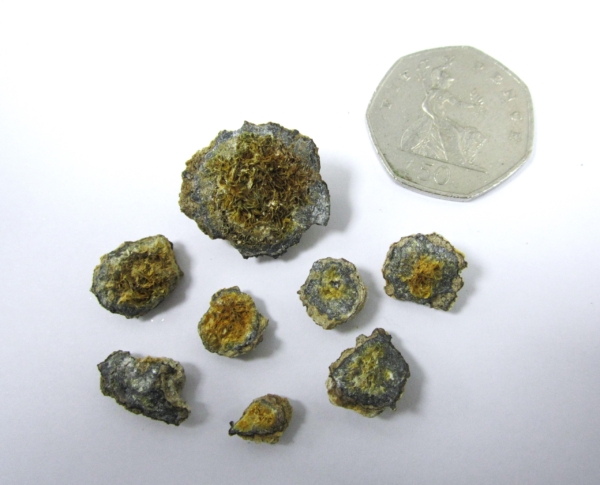
Tin Ingot Study
As a laboratory that has a particularly close relationship with tin mining, smelting and analysis, it is possibly no surprise that we have recently been asked to undertake a study into the purity of tin ingots destined for scrap. These were discovered in a garage with some known provenance indicating they were from two wrecks salvaged from around the Cornish coast in the mid-nineties, but originally date from much earlier. What was a surprise was the quantity and quality of surface blisters containing abhurite, identified after XRF and microscopic analysis.
Abhurite is a tin hydroxy chloride (Sn21Cl16(OH)14O6) named after a wreck found in the Sharm Abhur Cove, Jeddah in the Red Sea. Officially classified as a mineral in 1985, it is known from only a handful of locations worldwide, including two famous wreck sites around the Anglesey and Cornish coasts. The SS Liverpool sank in January 1863 en route from London to Liverpool, and the SS Cheerful sank in July 1885, eighteen miles NNW of St Ives, also en route from London to Liverpool. Both ships had stopped in Cornish ports to pick up tin ingots, and these have produced well-documented abhurite specimens.
The ingots supplied to Wheal Jane Laboratory for testing consisted of a batch known to have come from the SS Cheerful salvage, including some with readable smelter hot marks. However, the second batch of ingots are more of a mystery, believed to have been salvaged at approximately the same time as the Cheerful ingots but from an un-documented wreck.
The unknown wreck site ingots were not from local Cornish smelters of the 19th century but were from the same period. After cleaning and identification, it appears the ingots were from Sydney Australia, Singapore and Penang Malaysia. Included were “Kangaroo” smelter ingots which gives a probable date for the wreck of 1874 to 1877 as the smelter only operated during that three-year period.
So why would a ship containing a cargo of tin ingots from the other side of the world be wrecked off the Cornish coast in a period when Cornish tin mining and smelting was at its peak? It seems, from documentation in Australian newspaper articles of the time, that for a short period Australian and therefore probably Malaysian tin was shipped to Cornwall to be re-smelted and mixed with Cornish tin. The tin ingots were then stamped with Cornish hot marks and sold at a premium of over twice the original price due to the reputation of Cornish tin being the best in the world. However, the practice was relatively short-lived as it became clear that Australian tin was actually as good as, or of even better quality than, the Cornish tin.
It was during the cleaning process of ingots from the unknown wreck that possibly the most interesting find was made. As well as blisters containing abhurite, free tin crystals were found amongst the waste material. Further examination appears to show tin crystals in the abhurite blisters. Indeed, even though the exact mechanism that triggers their formation remains unknown, it appears that these different blisters were in various stages of showing metallic tin in the process of gradually changing to abhurite.


